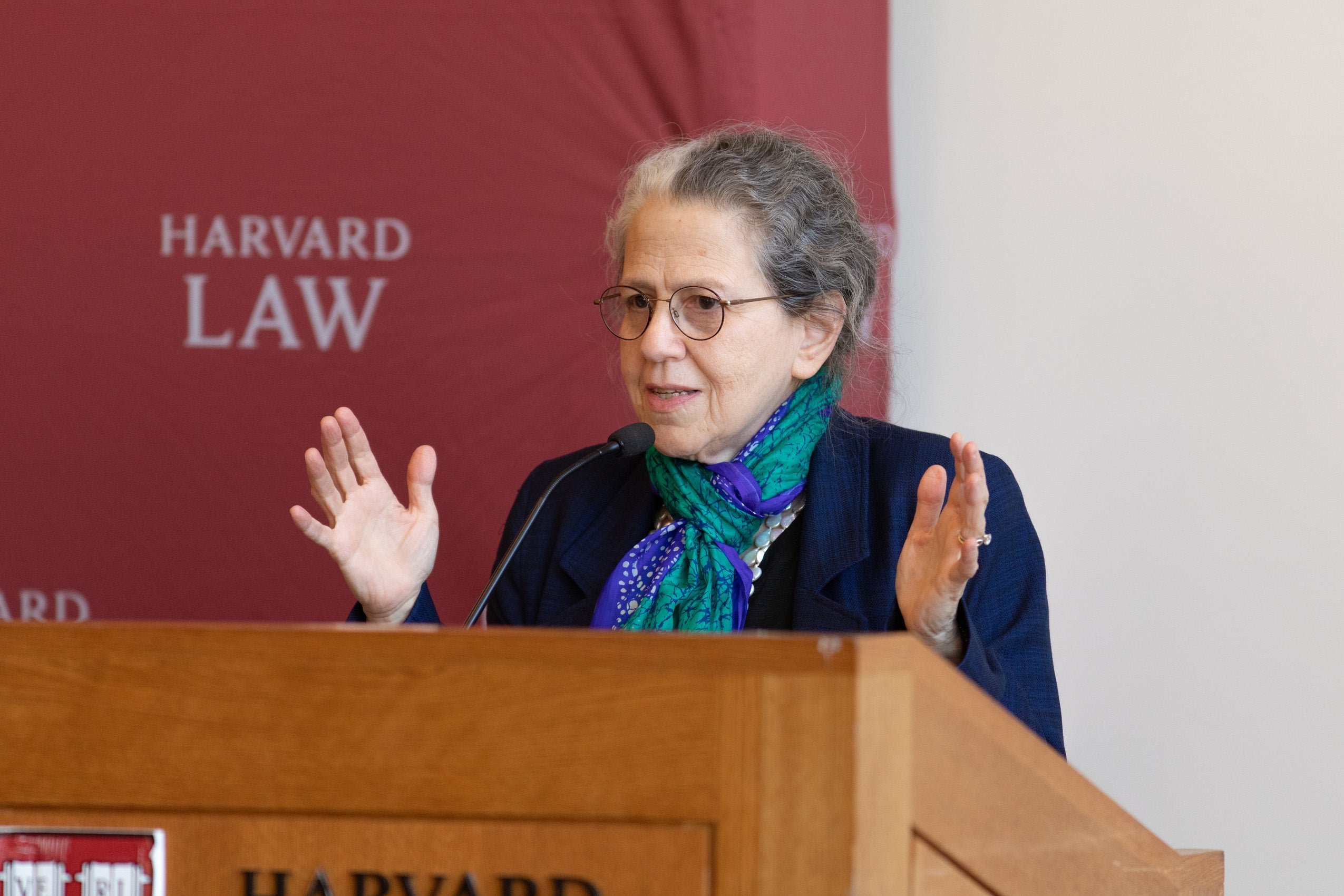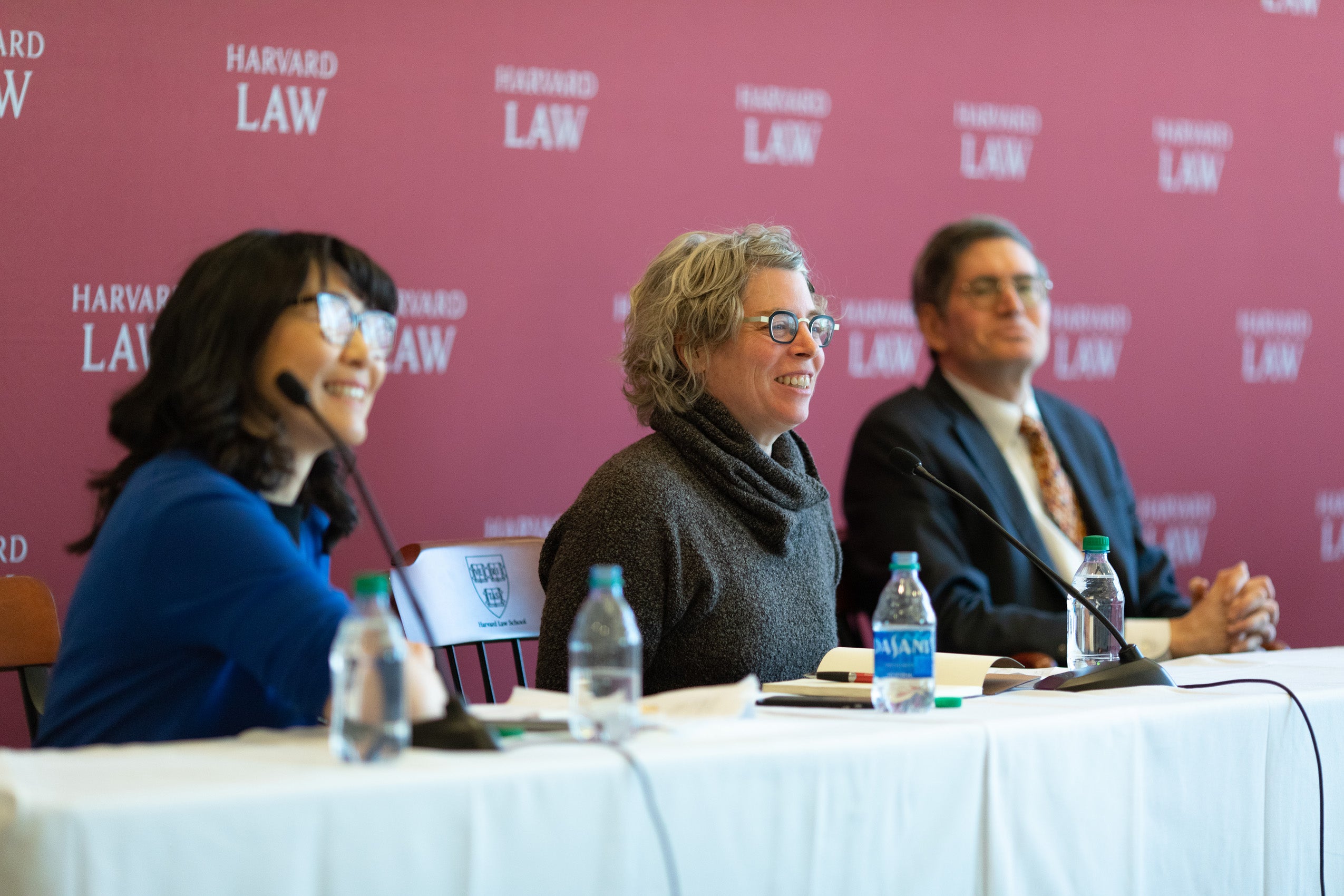Earlier this year Virginia became the 38th state to ratify the Equal Rights Amendment, continuing a struggle for gender equality that began with the 18th century suffrage movement. To commemorate International Women’s Day, a team of experts met at Harvard on March 9 to trace the history of the ERA to date, and to argue for its importance going forward.
This year also marks the centenary of the 19th Amendment granting women the right to vote, which Harvard Law Dean John F. Manning ’85 called “one of the most important political and constitutional reforms in the history of our nation” in his opening remarks. In the discussion that followed, HLS Professor Michael Klarman and Julie Suk, a professor of sociology at City University of New York, examined the related, and sometimes conflicting histories of the 19th Amendment and the ERA. Historian and Harvard professor Jill Lepore then asked the panel, including HLS professor Vicki Jackson, to consider how much value the ERA would have in the future.
As Klarman noted, both the ERA and the 19th Amendment had their genesis in the 1848 Seneca Falls Convention, the country’s first major gathering for women’s rights. At the time, Klarman said, suffrage wasn’t high on the agenda—rather, women were seeking their own version of social emancipation.
“Women who had participated in the abolitionist movement turned their attention to ways they were constrained by traditional gender laws and mores, which they analogized to slavery,” he said. Reforms were being demanded to property laws to protect women from drunk and dissolute husbands squandering what they’d brought into marriage. They also demanded a loosening of divorce restrictions. (Even women who’d been abandoned were often unable to get a divorce.) In fact, the right to vote was seen as the most radical demand on the agenda at Seneca Falls, he said, too radical for some organizers.

As the suffrage movement gained momentum, Klarman noted there were further conflicts—particularly among suffragists who objected that the 15th Amendment would give the vote to African Americans but not women. “Susan B. Anthony campaigned against its ratification, which led to some very strange political alliances,” said Klarman. “They literally worked with racist Democrats against black suffrage.” In his rapid-fire history, Klarman described women’s suffrage failing in 1870, and seeing success in the 1910’s after women had won the vote in many states. This was due in part, he said, to changes in the social climate, notably a rise in political progressivism after World War I. “An expansion can only happen when the bloc supporting it has taken control of the government.”
Drawing from her forthcoming book “We the Women,” Suk turned to the ERA and asked why it has taken so long to be ratified by 38 states. In at least one instance, she said, the 19th Amendment worked against it: In Adkins v. Children’s Hospital (1923), the United States Supreme Court used the 19th Amendment “as evidence that gender inequality was coming to a vanishing point,” and therefore labor protection for women was not necessary.

After this, some feminists came to distrust how the Supreme Court would interpret the ERA, Suk said. Then the amendment was largely “bottled up” in congressional committees between 1950 and 1970, and saw further setbacks afterward via a women’s rights backlash led by conservative activist Phyllis Schlafly. “She claimed that the ERA would destroy the family, and was able to convince a lot of mothers and housewives to work against it.” Meanwhile the ERA was facing inconvenient deadlines for ratification, and a conservative trend in Congress—all making Schlafly’s job easier.
The panel’s moderator, Jill Lepore, suggested that history has underestimated the part women themselves played in delaying both the suffrage movement and the ERA, and asked the panelists what could be learned going forward. “History is so important in understanding what might come next,” she said. “And if we haven’t really understood the nature of the opposition, we are in some peril.”



Klarman agreed that women, like other oppressed groups, have worked to their own disadvantage. “People who are subordinate under an ideology tend to internalize the ideology,” he said, though the same groups later take the lead in bringing change. Klarman also wanted to make another point. “I’m all for the ERA,” he said, “but I’ll go out on a limb and say that it’s not clear to me that the ERA being law would change a single outcome of what comes before a court [in the future]. But it’s important to have it symbolically.”
Suk responded that the ERA’s value is more than symbolic. “It’s one reason we got the shift in equal protection cases in the 1970s,” she said, when the Supreme Court began citing the ERA to say that sex discrimination should be scrutinized. “Not having an ERA undervalues work that women have put in for a hundred years to make constitutional change,” she said, and it could have an impact on cases today, for example, those regarding pregnancy discrimination.
Jackson argued both for the amendment process as a method of change, and for the ERA—even if its future value does turn out to be symbolic.
“Legally, the place an enacted ERA would have bite is if there were attempts to roll back the federal pregnancy discrimination act,” said Jackson. “As we have seen, the amendment will be open to a massive amount of interpretation, but its symbolic importance is considerable. In an era of Trumpian populism, we are engaged in a political struggle.”
